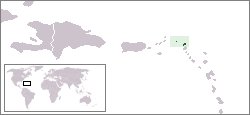 Anguilla (pronounced /æŋˈɡwɪlə/ ang-GWIL-ə) is a British overseas territory in the Caribbean, one of the most northerly of the Leeward Islands in the Lesser Antilles. It consists of the main island of Anguilla itself, approximately 26 km (16 mi) long by 5 km (3.1 mi) wide at its widest point, together with a number of much smaller islands and cays with no permanent population. The island’s capital is The Valley. The total land area of the territory is 91 km2 (35 sq mi), with a population of approximately 13,500 (2006 estimate). It lies east of Puerto Rico and the Virgin Islands and direct north of Saint Martin.
Anguilla (pronounced /æŋˈɡwɪlə/ ang-GWIL-ə) is a British overseas territory in the Caribbean, one of the most northerly of the Leeward Islands in the Lesser Antilles. It consists of the main island of Anguilla itself, approximately 26 km (16 mi) long by 5 km (3.1 mi) wide at its widest point, together with a number of much smaller islands and cays with no permanent population. The island’s capital is The Valley. The total land area of the territory is 91 km2 (35 sq mi), with a population of approximately 13,500 (2006 estimate). It lies east of Puerto Rico and the Virgin Islands and direct north of Saint Martin.
The Anguilla National Trust (ANT) was established in 1988 and opened its offices in 1993 charged with the responsibility of preserving the heritage of the island, including its cultural heritage. The Trust has programmes encouraging Anguillian writers and the preservation of the island’s history.
The island’s cultural history begins with the Taino Indians. Artifacts have been found around the island, telling of life before European settlers arrived.
As throughout the Caribbean, holidays are a cultural fixture. Anguilla’s most important holidays are of historic as much as cultural importance – particularly the anniversary of the emancipation (previously August Monday in the Park), celebrated as the Summer Festival. British holidays, such as the Queen’s birthday, are also celebrated.
Anguilla’s thin arid soil is largely unsuitable for agriculture, and the island has few land-based natural resources. Its main industries are tourism, offshore incorporation and management, offshore banking, and fishing. Many insurance and financial business are headquartered in Anguilla.
The economy of Anguilla is expanding rapidly, especially the tourism sector which is driving major new developments in partnerships with multi-national companies. This boom, beginning gently during 2005-2006, is accelerating through 2007 and is expected to continue for years.
Anguilla’s currency is the East Caribbean dollar, though the US dollar is also widely accepted. The exchange rate is fixed to the US dollar at US$1 = EC$2.68.
The economy, and especially the tourism sector, suffered a setback in late 1995 due to the effects of Hurricane Luis in September but recovered in 1996. Hotels were hit particularly hard during this time. Another economic setback occurred during the aftermath of Hurricane Lenny in 2000.
Notes from Wikipedia









